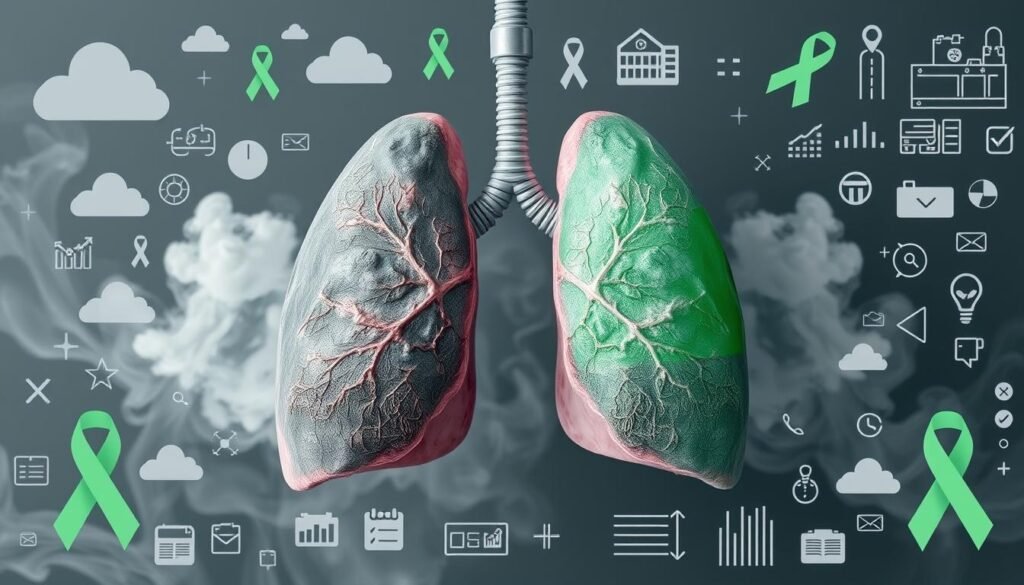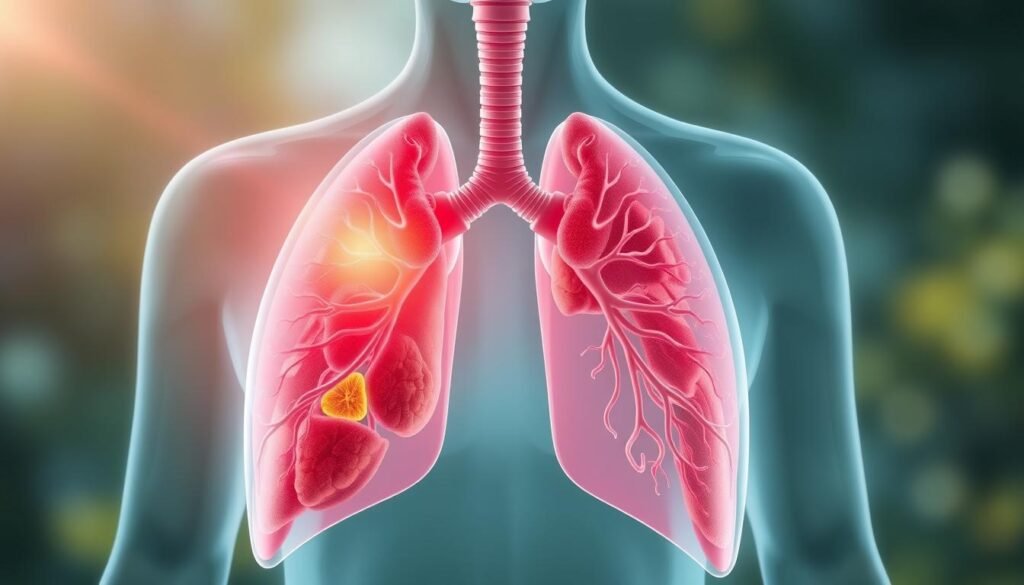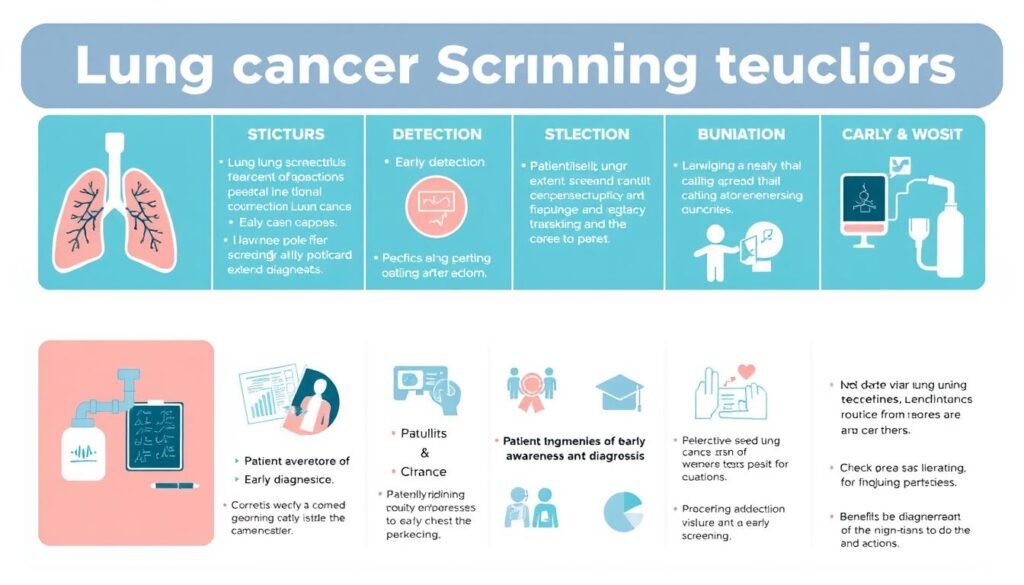Lung cancer is the culprit behind around 18% of all cancer deaths worldwide. In the U.S., it’s quite alarming that an estimated 237,000 Americans were diagnosed with lung cancer in 2022. Learning the key stats and understanding lung cancer can lead to early symptom recognition and better prevention. This piece covers essential lung cancer facts, from how widespread it is to the latest in lung cancer treatment options. We’ve pulled reliable info from the American Lung Association and other top health organizations to help save lives.
Key Takeaways
- Lung cancer remains the leading cause of cancer deaths in the U.S.
- Only 26% of lung cancer cases are diagnosed early, significantly impacting survival rates.
- Racial disparities exist, with people of color facing more severe lung cancer outcomes.
- Screening high-risk individuals can reduce mortality by up to 20%.
- Smoking is responsible for about 85% of lung cancer cases.
- Innovative treatment options are continually emerging through medical research and clinical trials.
The Prevalence of Lung Cancer in the U.S.
Lung cancer is a major health issue in the U.S. It stands out due to its high rates of cases and deaths. Current statistics show about 234,580 new cases in 2024. Both men and women are almost equally likely to be diagnosed. The average age for diagnosis is around 70, mostly affecting people over 65.
Lung Cancer as the Leading Cause of Cancer Deaths
This disease causes about 125,070 deaths every year. That’s more than breast, colorectal, and prostate cancer deaths combined. One in five cancer deaths is due to lung cancer. Despite more awareness, the death rates show we need better education and prevention.
Different groups face varying risks of lung cancer. Black men have a 12% higher chance compared to White men. Meanwhile, Black women have a 16% lower chance than White women. These differences show the need for health strategies that consider demographic factors.
| Statistics | Men | Women | Total |
|---|---|---|---|
| Estimated new cases (2024) | 116,310 | 118,270 | 234,580 |
| Estimated deaths (2024) | 65,790 | 59,280 | 125,070 |
| Lifetime risk of diagnosis | 1 in 16 | 1 in 17 | N/A |
| Current individuals diagnosed | N/A | N/A | 654,620 |
Fewer people smoking has led to less lung cancer cases and deaths. Early detection and better treatments are improving survival rates. Knowing about lung cancer and its numbers helps us take action. It pushes us towards better health efforts in our communities.
Understanding Lung Cancer Risks
Smoking is the top cause of lung cancer, linked to about 80% of deaths from the disease. This fact shows a big difference in risk between smokers and non-smokers. Still, even people who don’t smoke can face a high risk.
Main Risk Factors
Apart from smoking, other major things can lead to lung cancer:
- Radon gas: The second main cause of lung cancer in the U.S. is this gas. It’s more common indoors, posing a serious risk.
- Asbestos exposure: Working with asbestos raises cancer risk a lot, more so for smokers.
- Secondhand smoke: It’s the third leading cause, especially dangerous for non-smokers. It accounts for about 25% of lung cancer cases among them.
- Occupational hazards: Being around certain chemicals and radioactive ores at work can make lung cancer more likely.
- Family history: Having lung cancer in your family means you might be more at risk.
The Impact of Non-Smokers
Non-smokers can also get lung cancer, making up 18% of cases. In 2024, it’s expected that over 46,000 non-smokers will be diagnosed. They can be exposed to several risk factors:
- Radon gas in homes without good airflow.
- Secondhand smoke at home or work.
- Chest radiation therapy, which ups the cancer risk.
- Pollution in the air outside, a factor in 1-2% of lung cancer deaths.
https://www.youtube.com/watch?v=ihCnDjyJv5c
Interesting Facts About Lung Cancer
Lung cancer is more than a disease; it’s a global issue. It’s important to know these facts. They show the need for early detection and awareness.
Statistics that Matter
In 2022, lung cancer affected over 2.4 million people worldwide. It’s a leading cancer type. It’s the top reason for cancer deaths, with about 19% of all cancer deaths.
This shows the need for quick action if symptoms appear.
Demographic Disparities
Demographic disparities exist in lung cancer rates. Outcomes are often worse for people of color than for whites. This is due to late diagnoses and limited access to care.
Research shows 10-25% of patients never smoked. This suggests other factors like environment play a role. Equal access to healthcare could improve outcomes for everyone.

Recognizing Lung Cancer Symptoms
Knowing lung cancer symptoms is key for catching it early. Many people do not spot the symptoms until it’s late. However, some early signs should not be ignored. Spotting these signs early can help individuals get medical advice quickly.
Some common symptoms of lung cancer include:
- A persistent cough
- Coughing up blood or rust-colored sputum
- Chest pain that gets worse when you breathe deeply
- Hoarseness
- Unexplained weight loss and appetite loss
- Feeling short of breath and very tired
- Getting infections often, like bronchitis or pneumonia
- Starting to wheeze when you didn’t before
When lung cancer spreads, it brings new symptoms. These might be bone pain or headaches due to it reaching the brain. Others might include yellowing skin from liver impact or neck swelling. There are unique conditions too, such as Horner syndrome which causes droopy eyelids.

If you think you might have lung cancer, it’s critical to see a doctor soon. Acting fast can greatly improve your chances. By recognizing lung cancer symptoms early, you boost your shot at a better outcome. For more info, check out this reliable resource.
Lung Cancer Screening and Early Detection
Lung cancer screening is important for those at higher risk. It helps find cancer early, increasing the chances of survival. Low-dose computed tomography (CT) scans are effective in spotting lung problems. Studies show they can reduce lung cancer deaths by up to 20% in people at risk. Yet, only 4.5% of 8 million Americans who need it get screened regularly.
Importance of Screening
Screening for lung cancer on time is crucial. The American Cancer Society advises yearly screenings for those 50 to 80 who smoked a lot over the years. Early detection means more effective treatment options. Unlike chest X-rays, low-dose CT scans can actually save lives.
Current Screening Rates
Even with the benefits clear, not enough people get screened for lung cancer. Many don’t know how important it is or if they’re eligible. Raising awareness could boost screening rates. Most times, screening finds harmless issues, but further testing is always a good step. Learn more about early warning signs.

| Screening Characteristics | Low-Dose CT Scans | Traditional Chest X-Rays |
|---|---|---|
| Effectiveness in Survival Rates | Proven to reduce lung cancer mortality | No significant improvement in lifespan |
| Recommended Age Range | 50-80 years | N/A |
| Radiation Exposure | More than chest X-ray but less than standard CT | Lower than low-dose CT |
| Annual Screening Recommendation | For high-risk individuals | Not recommended |
| Incidence of False Positives | 12-14% initial screenings | Not typically tracked |
Advancements in Lung Cancer Treatment Options
Recently, lung cancer treatment has seen great changes. Thanks to new research, we now have better treatments that help people live longer and better. These new treatments bring hope of higher survival rates and improve life quality for those diagnosed.
Innovations in Medical Research
New research has led to big steps forward in treating lung cancer. Targeted therapies work on the tumor’s genetic changes. This makes treatments more effective and reduces bad side effects.
Doctors now use comprehensive biomarker testing to find the best treatment for each patient’s genetic makeup. This means more patients get treatments that really fit their needs. Also, a new technique called stereotactic ablative radiotherapy (SABR) is very promising. It gives much better survival rates, especially for early-stage lung cancer.
Also, more people are getting surgery, like Video-Assisted Thoracoscopic Surgery (VATS). It’s less invasive, so there’s less risk of dying in the hospital. This shows how modern surgery is making a big difference in treating lung cancer.
Keeping up with research in lung cancer is key to finding effective treatments. These advances not only make current treatments better. They also give us new knowledge that leads to future breakthroughs in fighting lung cancer.
Lung Cancer Statistics: A Closer Look
Lung cancer statistics offer important insights into fighting this disease. Knowing the numbers helps improve awareness and care. As we look to 2024, an estimated 234,580 new lung cancer cases are expected in the U.S. This accounts for about 11.7% of all new cancer cases.
While these numbers are high, there’s hope. Efforts to reduce lung cancer deaths are showing progress.
Current Incidence Data
The number of lung cancer cases in the U.S. is on the decline. This drop has been ongoing since 2006. In 2024, lung cancer deaths are projected to be 125,070. This will make up 20.4% of all cancer deaths.
The annual new case rate is 49.0 per 100,000 people. The chance of getting lung and bronchus cancer in one’s lifetime is around 5.7%. Early detection and action are key to fighting this disease.
Survival Rates and Trends
Survival rates for lung cancer are improving, thanks to medical progress and early diagnosis. From 2014 to 2020, the five-year survival rate rose to 26.7%. If the cancer is found early, this rate jumps to 63.7%.
From 2012 to 2021, new lung cancer cases fell by 2.0% each year. Death rates dropped by 4.1% from 2013 to 2022. These numbers give us hope. They show the power of research and better healthcare in saving lives.
| Statistic | Value |
|---|---|
| Estimated New Cases in 2024 | 234,580 |
| Percentage of All New Cancer Cases | 11.7% |
| Estimated Deaths in 2024 | 125,070 |
| Percentage of All Cancer Deaths | 20.4% |
| 5-Year Relative Survival Rate (2014–2020) | 26.7% |
| Rate of New Cases per 100,000 | 49.0 |
| Death Rate per 100,000 | 32.4 |
| Lifetime Risk of Developing Lung Cancer | 5.7% |
| Prevalence in 2021 | 610,816 |
Lung Cancer Awareness and Prevention Efforts
Lung cancer awareness is key in educating people about risks. By knowing the causes, people can take steps to stay healthy. Smoking cessation and avoiding harmful substances like radon are vital.
How to Reduce Risk
There are effective ways to lower lung cancer risk:
- Quit smoking: Smoking causes nearly 9 out of 10 lung cancers. Stopping smoking is crucial for reducing risk.
- Avoid secondhand smoke: Non-smokers exposed to secondhand smoke have a 20-30% greater risk of lung cancer.
- Test for radon: Radon leads to over 20,000 lung cancer deaths yearly in the U.S. Homes should be tested for radon, as 1 in 15 have high levels.
- Screening: Yearly screening is recommended for those 50 to 80 years old who smoked a lot. It helps find lung cancer early, making treatment more effective.
- Support awareness initiatives: Helping with lung cancer awareness activities spreads the word on preventing it.
The American Lung Association pushes for lung cancer awareness. They empower communities with resources and info. For more on lung cancer prevention, visit this informative page.
Conclusion
Understanding lung cancer is crucial. This includes knowing its symptoms, risks, and the latest treatments. Every two minutes, someone in the United States is diagnosed with lung cancer. This fact shows how important early detection is.
Lung cancer survival rates have gone up a lot in the past five years. This improvement shows why supporting research and education about lung cancer is necessary.
Even with these advancements, lung cancer screening rates are low. In 2022, only 16.0% of people who could have been screened actually were. This low number shows we need to talk more about the benefits of screening.
Early detection can lower death rates by up to 20%. It does this by finding tumors when they are easier to treat. This fact makes screenings a key step towards saving lives.
We can reduce lung cancer risks by promoting preventive measures and regular screenings. It’s also important to use resources like recognizing early symptoms. Working together, we aim to diagnose lung cancer sooner, treat it more effectively, and, if we can, prevent it.